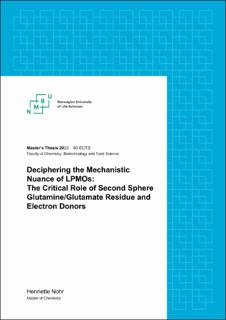| dc.description.abstract | Lytic polysaccharide monooxygenases (LPMOs) are crucial copper-dependent redox enzymes renowned for ability to oxidize recalcitrant polysaccharides, such as cellulose and chitin. Although they possess significant biotechnological potential, the intricate mechanistic aspects of LPMOs are yet to be fully understood.
This thesis emphasizes the universally conserved second sphere glutamate/glutamine residue within the LPMO active site. Employing site-directed mutagenesis, we fashioned various mutants of two LPMOs, SmAA10A and NcAA9C, to ascertain the function of this pivotal residue. Specifically, Glu60 in SmAA10A was altered to glutamine (E60Q), aspartate (E60D), or asparagine (E60N). Concurrently, for NcAA9C-Q164, mutations included changing glutamine to glutamate (Q164E), aspartate (Q164D), and asparagine (Q164N). The data unveiled that these mutations significantly altered enzyme activity.
Notably, all mutants demonstrated diminished activity relative to their wild type counterparts, a pattern consistent with observations by Bisarro et al., 2020. Moreover, turnover for the SmAA10A variants in the presence of the hydrogen peroxide quenching horse radish peroxidase (HRP) showed that the wild type was inhibited the least. This aligns well with the proposed hydrogen bonding role of Glu60 in catalysis.
Beyond the structure-function relationship, we explored the enzyme’s reliance on electron donors during catalysis. NcAA9C experiments suggest that varied electron donors can engage LPMOs, although with differential efficacies. Interestingly, the reductants (gallic acid and cysteine) that resulted in low catalytic rates experienced less degree of inactivation compared to when ascorbic acid was used as the reductant for the mutants of NcAA9C. Combined, this study underscores the indispensable roles of specific residues in LPMO efficacy and the impact of reductant selection on their performance. | |

